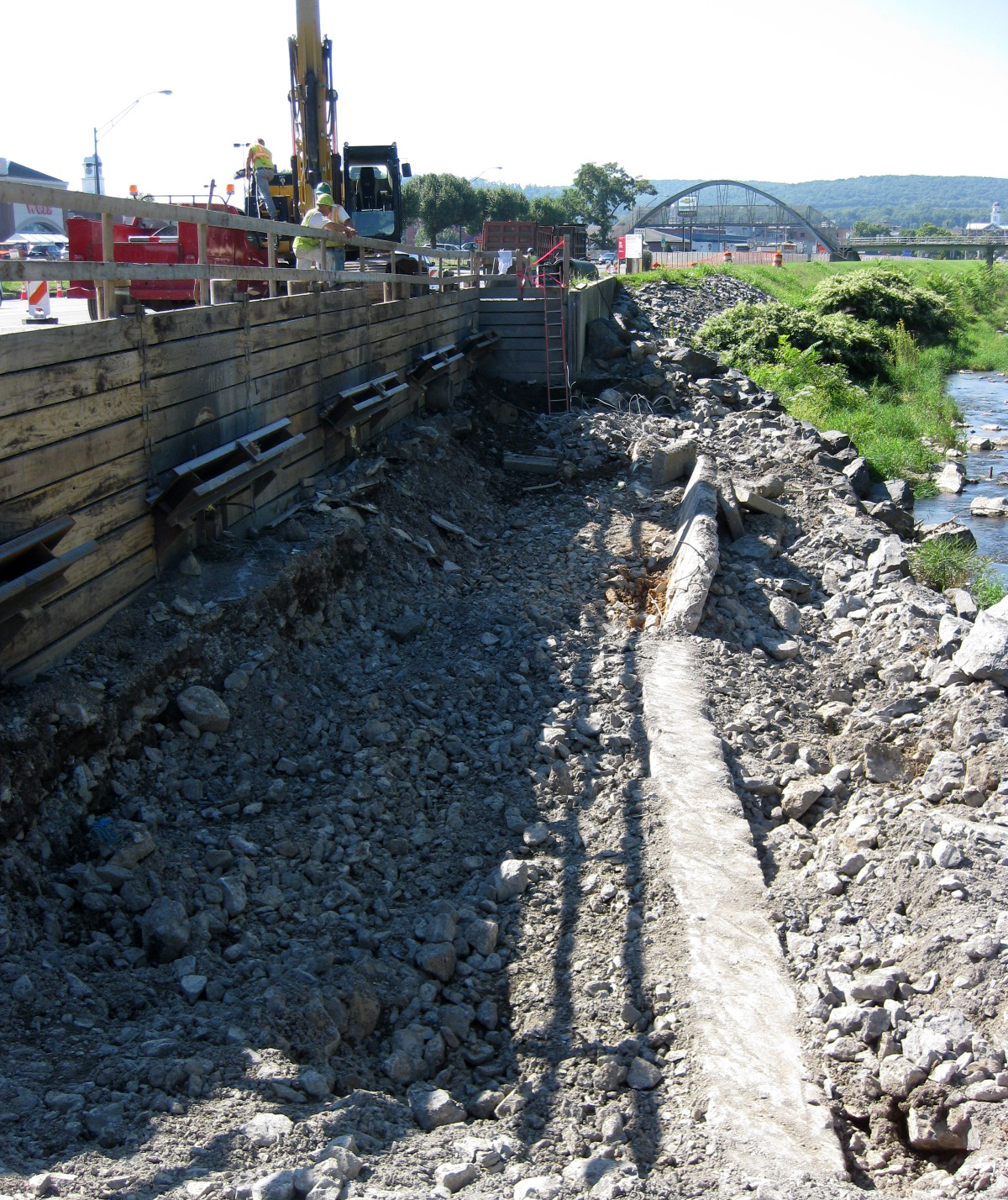 High-water events happen (most recently Tropical Storm Lee in September 2011), and they bring tremendous amounts of fast-moving water that can damage levee embankments and other project features. When that happens, the Baltimore District will work with the local sponsors to identify and assess the damages and create a construction repair plan. Under the authority of Public Law (PL) 84-99, the district can approve these plans and provide funding. As a result of the 2011 flood event, the Baltimore District approved over $8 million in construction repairs for multiple flood-risk-management systems along the Susquehanna River in southern New York and central Pennsylvania. For example, this photo shows a 60-foot-long floodwall in the Borough of Danville, Penn. that was torn down, as a result of Lee, in order to construct a new floodwall, which was completed in fall 2014. View more photos of the construction: http://bit.ly/CWphotos.
High-water events happen (most recently Tropical Storm Lee in September 2011), and they bring tremendous amounts of fast-moving water that can damage levee embankments and other project features. When that happens, the Baltimore District will work with the local sponsors to identify and assess the damages and create a construction repair plan. Under the authority of Public Law (PL) 84-99, the district can approve these plans and provide funding. As a result of the 2011 flood event, the Baltimore District approved over $8 million in construction repairs for multiple flood-risk-management systems along the Susquehanna River in southern New York and central Pennsylvania. For example, this photo shows a 60-foot-long floodwall in the Borough of Danville, Penn. that was torn down, as a result of Lee, in order to construct a new floodwall, which was completed in fall 2014. View more photos of the construction: http://bit.ly/CWphotos.
Under PL 84-99, the Chief of Engineers, acting for the Secretary of the Army, is authorized to undertake activities including (but not limited to) disaster preparedness; advance measures; emergency operations (flood response and post flood response); rehabilitation of flood control works threatened or destroyed by flood; and protection or repair of Federally-authorized shore protective works threatened or damaged by coastal storm.
For more info on Baltimore District Emergency Operations, please click here.
Preparedness: PL 84-99 establishes an emergency fund for preparedness for emergency response to natural disasters; for flood-fighting and rescue operations; for rehabilitation of flood control and hurricane protection structures. Disaster preparedness activities include coordination; planning; training; and conduct of response exercised with local, state and Federal agencies.
Response Activities: PL 84-99 allows the Corps of Engineers to supplement state and local entities in flood fighting in urban and other non-agricultural areas under certain conditions (Engineering Regulation 500-1-1 provides specific details). All flood-fight efforts require a Project Cooperation Agreement (PCA) signed by the Public Sponsor and a requirement for the sponsor to remove all flood-fight material after the flood has receded. PL 84-99 also allows for “advance measures” assistance to prevent or reduce flood-damage conditions of imminent threat of unusual flooding.
Rehabilitation: Under the authority of PL 84-99, an eligible flood-protection system can be rehabilitated if damaged by a flood event. The flood system would be restored to its pre-disaster status at no cost to the Federal system owner, and at a 20 percent cost to the eligible non-Federal system owner. All systems considered eligible for PL 84-99 rehabilitation assistance have to be in the Rehabilitation and Inspection Program (RIP) prior to the flood event. Acceptable operation and maintenance by the public levee sponsor are verified by levee inspections conducted by the Corps on a regular basis. The Corps has the responsibility to coordinate levee repair issues with interested, Federal, state, and local agencies following a natural disaster where flood control works are damaged.
Significant progress has been made for rehabilitation work on projects impacted by Tropical Storm Lee and Irene. Projects completed within the Rehabilitation Inspection Program include: Athens, Danville, Duryea, Lebanon, Plymouth, Wyoming Valley, and Sayre Phases I and II in Pennsylvania; Atlantic Coast of Maryland Shoreline Protection that included dredging and placement of 355,000 cubic yards of sand on the beach, repairs to the dunes and fencing and planting of dune grass in Maryland; and Bainbridge, Binghampton, Endicott, Johnson City, Greene, and Vestal in New York.
There is currently no construction work scheduled to be completed in Fiscal 2015 and Fiscal 2016.